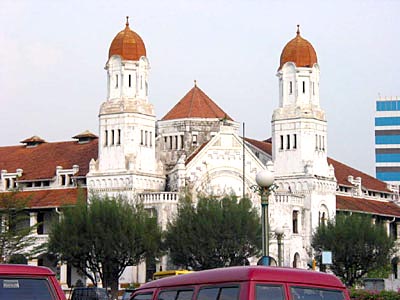Lawang Sewu, Knockin 'on a Thousand Doors
Selasa, 29 November 2011
0
komentar

Lawang Sewu is an old building dutch heritage, located in Semarang, Central Java, which is the office of the Nederlands-Indische Maatschappij or NIS Spoorweg. Lawang Sewu was built in 1904 and completed in 1907. The position of the building is on the roundabout Lawang Sewu Young Monument formerly called Wilhelmina Plein.
Local people call it Lawang Sewu (Thousand Doors) since the building has a door in large quantities (despite the fact that doors are not up to a thousand, perhaps also because the window height and width of this building, the community also regard it as a door).

Lawang Sewu of ancient buildings and magnificent two-story, in which after the independence of Indonesia is used as the office of the Railway Bureau Indonesia (DKARI) or PT Rail is now Indonesia. Additionally Lawang Sewu once used as Infrastructure Agency Office of Regional Military Command (Kodam IV / Diponegoro) Regional Office (Regional Office) Department of Transportation Central Java.

During the struggle, Lawang Sewu has its own historical record of events during a five-day battle in Hyderabad (14 October to 19 October 1945) at Lawang Sewu this be the location of a great battle between youth AMKA or the Young Railway against Kempeitai and Kidobutai, Japan . Now, Lawang Sewu included as one of 102 ancient or historic buildings in the city of Semarang that should be protected.
In the event the five-day battle, killed dozens of the Young Railway (AMKA). Five of them were buried in the front yard building Sewu Lawang, they are: Noerman, Salamoen, Roesman, RM and RM Moenardi Soetardjo.
Currently Lawang Sewu 181-year-old and the building was empty as well as the infamous haunted buildings and spooky. Occasionally used as a place of exhibition, including Semarang Tourism Expo and Expo. Once there was also a discourse that want to turn it into a hotel. In 2007, Lawang Sewu also used to film with the same title to the building.
Lawang Sewu basement was originally built for the purpose of circulation space and cooling the building, because in the basement is filled with water. Construction of basic basement Lawang Sewu use of natural stone slabs so that the air / cold atmosphere.
At the time of Japanese occupation, the basement Lawang Sewu functionalized into the detention room (no room detainee standing and squatting) and also the execution chamber (beheaded with samurai). Lawang Sewu basement has also been used as a test of courage by one TV station.
The top of Lawang Sewu, attic above the Dutch era in storage to use as railway parts. When the Japanese came to power in use as a prison and torture and place. The Japanese prisoners were hanged on poles that are in this place, one of the curved roof truss pole by a bullet cannon (or mortar) when the battle occurred five days in Hyderabad
TERIMA KASIH ATAS KUNJUNGAN SAUDARA
Judul: Lawang Sewu, Knockin 'on a Thousand Doors
Ditulis oleh Belibuku.web.id
Rating Blog 5 dari 5
Semoga artikel ini bermanfaat bagi saudara. Jika ingin mengutip, baik itu sebagian atau keseluruhan dari isi artikel ini harap menyertakan link dofollow ke http://bukutentang.blogspot.com/2011/11/lawang-sewu-knockin-thousand-doors_29.html. Terima kasih sudah singgah membaca artikel ini.Ditulis oleh Belibuku.web.id
Rating Blog 5 dari 5



0 komentar:
Posting Komentar
terima kasih kunjungannya, jika tak berkeberatan silahkan tinggalkan jejak anda dengan berkomentar di sini..